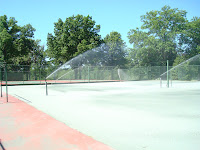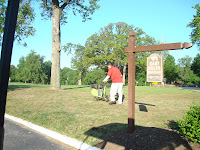In 1995 when the greens were resurfaced, a product called Profile was tilled into the greens. If you've ever attempted to till a flower bed or garden, you understand how easy it is to not get consistent tilling across the complete site or to get the products you are attempting to blend together in the proper ratios. Here is a link to learn more about Profile.
http://www.profileproducts.com/en/_docs/PPC%20Sell%20Sheet%20No%20Logo.pdf
This product was incorporated to reduce localized dry spots and to provide for more air space for our greens which do not have drainage systems under them. Localized dry spots are soils which are water repellent and are difficult to get wet. In many cases, these areas do not receive proper irrigation and or have a tendency to dry out quicker than other sights. Humps and bumps on greens and areas facing to the west have a tendency to drain or dry quicker causing this phenomenon. We incorporate a number of cultural practices to combat this issue:
- Aerify regularly to break up the soil profile and allow for water penetration.
- Use wetting agents which help the soil/sand accept moisture.
- Hand water greens or spray spots of the greens that we know have a tendency to dry quicker than others. We attempt to do this usually early in the morning because if you wait for the spots to show up in the heat of the day, it is difficult to get the spots under control before end of the day. We use a soil probe which allows us to pull out a small core of sand to determine if it has enough moisture. I have also used in the past a pair of polarized sunglasses which shows turf that is becoming stressed or is not as green as the turf around it. Sounds like a gimmick but it does work. It can drive your eyes a little crazy from the red coloration that you are bombarded with though.
Turf stress glasses
http://mvh.sr.unh.edu/mvhtools/psd_filters.htm
Localized dry spots FAQ
http://www.gcsaa.org/files/lds1.pdf
I have an email in to the company that manufactures the profile product to discuss potential issues with them. You can see the layering on this green is at the bottom of the tee. The orange material is the profile. This is at a depth of about 3" and is from a narrow ribbon width to sometimes 1/4" thick. Aeration over the years has helped to break up this situation somewhat but it is impossible to completely cover every spot on a green. Aeration can normally change about 5-10% of the surface. This product is to be blended thoroughly and is an additive to the greens mix. I believe the layering could create excessive amount of moisture at or directly above the area that is layered. Its interesting that when you pull a new hole out of the ground, many times the hole will break at this area of high concentration of material. In my mind this occurs because of the lack of strength in rooting below that area. No scientific proof, just a thought.
The picture below shows you the approximate width of this band of profile.

This is the view of a layer of material where the plug pulled apart while attempting to pull the new hole out of the green profile.

The following views are from a number of greens that were holding water from rain which had happened more than 24-36 hours ago.
The view below is of Green #11 which is one of our flatter greens. As you can see, the hole was almost completely full of water. Water mean less air space for roots which is not good. Water also is a great conductor of heat and cold. We hope as summer arrives to Glen Echo that we can control our water. Natural rain is great at times but we like to control the amount of water that is placed on our greens. The more moisture in the summer usually equals increased levels of heat that is held into our greens which can lead to catastrophic consequences for our shallow rooted turf. Good microbes which are used to help breakdown food for our roots are killed off and pathogens of all type begin to attack our green plant system.

This is the hand pump we use to evacuate water from the hole.












 d the club house
d the club house





































